Power - The Top Floor of the Architecture of Dynamics
The bottom four levels of the Architecture of Dynamics are now in place. It is time to add the final floor. We combined Distance with Force to construct our 4th floor – Work. Now we need to combine Time with Work to construct the top level – Power. Force must be applied to an object over Distance to do Work. Power is how quickly this Work occurs. Common sense tells us that doing the job is not enough; the task must be accomplished in a timely fashion as well. This reasoning leads to the notion of power.
Complete Architecture of Dynamics
Check out our completed structure.
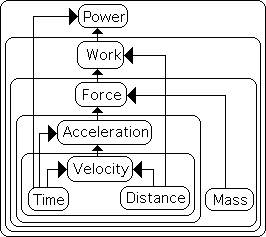
Beautiful. Isn't it?
Applies Equally to Dynamics of Matter and Information
Remember, this architecture applies equally to the Dynamics of Matter and the Dynamics of Information. Physics has firmly established the connection of this architecture with the material world. How can this completed structure possibly apply to information? How is it possible that information can do work at all, much less at any particular rate of speed?
How does digested information exhibit Power?
This question muddles constructs. We remember from a previous discussion that raw information has no velocity and therefore no dynamics. In contrast, digested information has dynamics related to the dimensionality it acquires when digested by the Living Algorithm. The clarified question becomes: how does digested information exhibit Power? Answering this query is the focus of this organized group of letters.
Energy employed to Change the State of a System
In the prior article we developed the notion of Info Energy in the Living Algorithm System. We argued that a common feature links all forms of energy. Energy has ability to change the state of the system it belongs to. This is true whether we are speaking of mechanical, thermodynamic, electrical or even human energy. Because the information in a data stream has the ability to change the state of the Living Algorithm System, we made the logical inference that this is also a type of energy – info energy.
Energy can be used more or less efficiently
As mentioned, energy has the ability to do the work of changing a system. Energy has other common features, as well. It can also be stored as potential energy for use at a later date, or be employed without doing any work at all. To be effective work must be performed in a timely fashion. Power is the measure of how quickly work is done. In this sense, energy can be used more or less efficiently. Information Dynamics, the name of this extended study into the relationship between Mathematics & Behavior, is all about how to utilize info energy more efficiently.
Work changes the state of a System
In the prior article we discussed Info Energy in the Living Algorithm System. How does this energy operate? What does it do? What does it accomplish? We've seen that the info energy in the Living Algorithm System behaves in a similar fashion to other energy systems. But what is the relevance? To answer these questions we must explore the notion of info power.
Work & Power: technical sense
To begin our discussion let’s explore the meaning of the words ‘work’ and ‘power’ in the context of information transfer. We are employing these words in their technical sense, as a Physicist would. Although the scientific definitions are close to our common sense meaning, as we shall discover, they actually have an exact scientific meaning. Let’s start with the concept of work.
Info Energy performs the Work of changing the Living Algorithm System
In a material system it is easy to imagine work being done – for instance lifting an object from the floor to a tabletop. Work occurs when we change an object’s position. How does this physical example apply to information? In similar fashion, work is performed in the Living Algorithm System when the state of the system (the Living Average) is changed. Info energy is the vehicle by which this work occurs, as was discussed in the prior article.
Info energy does no more work once practical maximum achieved
Let’s review this process. Let’s assume that the resting state of the Living Algorithm System is zero. Turning on the System consists of generating a sequence of ones. The data flow of 1s gradually changes the state of the System (the Living Average) from 0 to 1. Roughly speaking, it takes 120 of these pulses of ‘1’ energy (the raw data) to perform this task. However, once the System reaches its 'practical' limit, no more work is accomplished. More ones are required to maintain the state; but no matter how many are added, the changes to the System are negligible. Accordingly, no more work is done. The System has achieved its practical maximum – the goal of all that striving.
Power = How quickly Work is Accomplished
Data Stream & Living Average
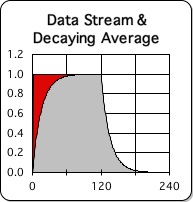
A Graphic Example
Let’s explore a graphic example of this process to elucidate these notions. The graph at the right is the result when the Living Algorithm digests a sequence of 120 ones followed by 120 zeros. The grey curve in the foreground is a visualization of the Living Average – the state of the system. This grey area obscures the red block which peeks out from behind and represents the raw data – the sequence of 120 ones.
Most Work accomplished at beginning of Curve
Remember, work changes the state of the system. Note: Changes are negligible at the end of the ones sequence, as the Living Average curve levels out (approaching one forever). Accordingly, the amount of work accomplished is negligible. Most of the work is done in the early stages of the 1s sequence. The evidence of the Work is seen in the Living Average graph when the curve shoots upward. The maximum amount of work the System can do is to raise the Living Average from 0 to 1, thereby changing the state of the system. While work is defined as force over distance, power is defined as work over time. Accordingly, the power of a system is associated with how quickly work occurs. For instance, the measure of the power of a heating system is how quickly the temperature rises. Because a wall heater takes much longer to heat a house than central heating, it is said to have less power. In general we like to maximize the power of a system.
Restaurant Example: Power Required to Keep Job
This is not too far off from common sense thinking. We appreciate that a waiter does the work of moving plates laden with savory treats to our table, but we don’t want him to move at a snail’s pace to accomplish this task. We would certainly urge him to increase the power of his system by stepping up the pace - doing the work of transporting food and providing services more quickly. In fact, it is essential that a waiter exhibit sufficient power at his restaurant to retain his job.
Every Worker must exhibit Power (perform Work in a timely fashion).
This principle applies to any job. Doing the work alone is not enough. Every individual, whether student, teacher, laborer, white-collar worker, businessman or corporative executive, must execute her work in a timely fashion (with sufficient power) to maintain her position. In general those individuals that manifest the most power (accomplishing their jobs most rapidly) are considered to be the best teachers, managers, students, or workers. In short, Power is the speed with which work is accomplished.
A consecutive sequence of ones: most powerful way to raise info system from 0 to 1
Reiterating, work is changing the state of the System, whether it be material, psychological or informational. Performing work as quickly as possible maximizes the power of any system. Each system imposes innate limits on the speed at which work can be done. Obviously, if waiters move too quickly, they spill food and run into their guests. Let us suppose that the only limit imposed on an info system is that the data stream can only consist of zeros or ones. Under this constraint, it makes sense that an uninterrupted stream of ones is the quickest way to do the work of raising the Living Average from 0 to 1. The rise of the Living Average will slow if a zero is introduced into this sequence. With this in mind a data stream consisting solely of ones has the most power to do work, as it changes the state of the info system most rapidly.
Productivity = Volume of Work accomplished over Time
Shifting from task to task to maximize productivity
Once a task is accomplished, the system has expended its power to do work on that task. In order to exert any more power, a new task must be assigned. For instance, to maximize the power of an employee to do work, it is necessary to assign an ongoing sequence of tasks. If the waiter paused to enjoy his handiwork after every task, he would not exhibit enough power to retain his job. Instead he shifts immediately from task to task to maximize his productivity - the volume of his work.
Sequence of Zeros: best way to resume work after maximum reached
After the Living Average attains the 'practical' maximum (one) of our info system, the best way for our System to resume work would be to shift to a sequence of zeros (the state of zero). In this case the new task is to move the info system from one to zero. Any ‘one’ that interrupts this flow of zeros slows the descent of the Living Average – decreasing the power of the system.
Shifting from 'Task' to 'Task' maximizes productivity of Triple Pulse Info System
Conversely, after our info system has reached its practical minimum (zero), the best way for work to resume is for the data stream to shift to a series of 1s (the state of one). This shift maximizes the power of the info system of do work. Once our info system reaches its 'practical' maximum (one), the data stream shifts to a series of zeros. Accordingly, the System’s 'task' alternates between changing its state (its numerical ‘location’) from ‘one to ‘zero’ and back again. It is this alternation that empowers the System. Empowering the System maximizes productivity. Productivity is the volume of work accomplished over time.
Difference between Power and Productivity
Before moving on, let us speak about the difference between power and productivity. Power is a measure of how quickly work is accomplished. Productivity is a measure of how much work is accomplished. Obviously power and productivity are related. The more quickly work is done, the more work is accomplished. However, if work is performed too quickly, this can have a negative impact upon the amount of work that is completed. For instance, if a marathon runner sprints at the beginning of the race, he might not have enough stamina to reach the end. Or his power might fall off at the end and he will lose the race. Accordingly, to maximize productivity and employ his power most efficiently, the runner must pace himself. He doesn't expend his limited power in the initial phases of the competition, so that he still has a little kick left for the end of the race.
Efficiency & Conservation of Energy apply to Productivity, not Power
If power is the only consideration, as in a sprint or in speed trials, then conservation and efficiency are not important. In general, the most powerful cars are the least fuel-efficient. If productivity is a consideration, then conservation and efficiency become of prime importance. For instance, to maximize the possibility of a long and productive life, the individual conserves his biological energy by using it as efficiently as possible. How does efficiency and conservation apply to the Living Algorithm System of digesting information?
Maximizing the Efficiency of the Living Algorithm System
Alternating from ones to zeros at specific intervals maximizes Triple Pulse Productivity
It is evident from this analysis that a data stream comprised of a consistent alternation of the state of one with the state of zero maximizes the productivity of a binary info system. This describes the ideal Triple Pulse data stream. Accordingly, this specific sequence of ones and zeros maximizes the Triple Pulse Info System's ability to do work. Specifically, this is the work of moving the Living Average from one numerical location to another. Could this data stream, which accomplishes the most work in the least amount of time, also maximize the energy efficiency of the System?
Triple Pulse Info System: the Living Algorithm digests a 360 bit Binary Data Stream
To refresh our memory with a little repetition, the Triple Pulse Info System has a few requirements. The Triple Pulse System is the result when the Living Algorithm digests a particular type of data stream. This particular data stream is binary (only consisting of ones and zeros) and is 360 units in duration. The ideal Triple Pulse data stream consists of a regular alternation between the state of one and the state of zero. As mentioned, this sequence is ideal because it maximizes the productivity of the System. Let's examine a graph derived from the Triple Pulse sequence to see what it shows regarding productivity in our binary Info System.
Triple Pulse Graphs: Visualizations of the relative Power of Info System
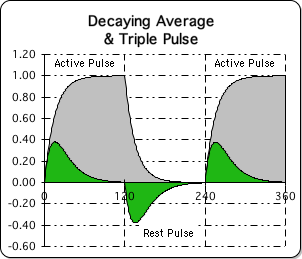
The graph at the right shows two curves and two areas. The grey area outlined with what we shall call the grey curve is the Living Average. The green area outlined by the green curve is the classic Triple Pulse. The two are intimately connected. Both curves are related to the Power of the System. Let's see why.
One unit of Work during Active Pulse
During the duration of the Active Pulse, the state of the System, the Living Average, rises from 0 to 1. Hence, the System performs one mathematical unit of work during the first pulse.
Work a magnitude. Power a rate of change.
Work is a simple magnitude. Power is a rate of change. For instance, we can say that the assembly worker painted 100 clock faces. This quantity tells us how much work was accomplished, but does not tell us how quickly she performed the task - her power. For that information we need to know how long it took her to complete the task. If Sue takes 4 hours to paint 100 clock faces and Jane take 5 hours to paint the same number, Sue's power could be quantified as 25 clock faces per hour and Jane's power as 20 clock faces per hour. In similar fashion we could say that the overall power of our System is 1/120 because it takes 120 moments, the duration of the Active Pulse, to change the state of the System by one unit.
Power is constantly changing in the Triple Pulse Info System.
Because the factory worker performs her task at a fairly steady rate, her total power reflects the rate at which each individual clock is painted. This is not true of the Triple Pulse System. The work of changing the System is not steady at all. Instead the state of the System, as indicated by the Living Average, rises rapidly at the beginning and then slows down at the end of the Pulse (shown in the graph). Accordingly, a unique amount of work is accomplished each moment. Therefore, each moment is associated with a different rate of change and exhibits a unique amount of power. As such, the overall power of our System tells us very little about the individual moments.
Slope of Grey Living Average Curve indicates Moment-to-Moment Power of System
To determine the moment-to-moment power of the System, one need only view the slope of the Living Average’s grey curve: the steeper the slope, the greater the power. Vice versa, the flatter the slope, the less the power. It is evident that the power is greatest at the beginning of the curve and falls to a minimum as the curve approaches 1 as a limit.
Active Pulse suggests the System's Power Fluctuation
The green curve of the Active Pulse suggests this power fluctuation. The green curve rises to a maximum as the grey line rises rapidly and then falls to a minimum as the grey line flattens out. Similarly, as the grey line falls rapidly during the second green pulse, the now familiar Rest Pulse, the green line reaches its minimum. As the grey line flattens, the green line returns to zero. Accordingly, the green line provides an approximate visualization of the changing power exhibited by the System. As is visually apparent, the power of this particular system is constantly changing.
Power, a rate of change; Work, the quantity of change
Reiterating to reinforce memory: Power is a measure of how rapidly work occurs. Power is not a measure of how much total work occurs. Power is an instantaneous measure that indicates a rate of change (a speed), not a cumulative measurement. However, Power does reflect how much Work is accomplished at each moment, or time segment, along the way. Work, on the other hand, is the measure that indicates how much was accomplished – the amount the system changes.
Work requires Energy. Energy does not always produce Work
Work has another interesting feature. Work requires energy expenditure in the worlds of both Matter and Information. A constant flow of info energy, the 1s, powers the System. As is visually evident from both curves, most of the work of changing the system occurs at the beginning of the cycle. The work tapers off to almost zero at the end of each cycle. This does not mean that energy has stopped. It just means that this energy is not performing any more work. The energy is maintaining the system, but not changing it anymore. To avoid 'wasting energy' on maintenance, the data stream shifts from 1s to 0s at regular intervals. This strategy maximizes productivity.
Triple Pulse Sequence maximizes productivity of System
It is evident that the Living Algorithm System is most productive when the Triple Pulse sequence is utilized. Let us suppose that the Living Algorithm is the method by which living systems give meaning to the constant stream of information to which they are exposed. Because the Triple Pulse sequence is most productive, it makes sense that living systems would evolve to regularly utilize this sequence to digest information. We saw a clear-cut example of this phenomenon in the article on the Biology of Sleep.
Triple Pulse System: Mathematical Versatility and Limits
Any uninterrupted number pair can be utilized to generate Triple Pulse
Any Number Pair generates a Triple Pulse
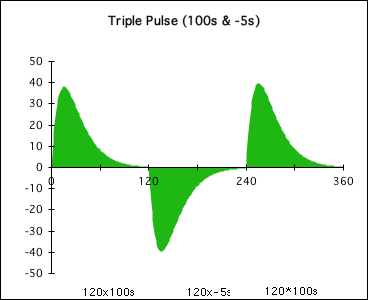
Although we have confined the Triple Pulse sequence to ones and zeros for ease of analysis, any number pair can be employed with equally productive results. It is essential, however, that each number sequence is uninterrupted for the prescribed duration. As an example, the classic Triple Pulse graph at the right is generated by an alternation of the state of '100' with the state of '-5'. The mathematical fact that any number pair can be utilized provides our versatile System with more universality. The Living Algorithm System is not restricted to moving from one to zero, but can move from any numerical location to any other numerical location.
Duration of Data Stream's Numerical State must be just right, not too long or too short
A. Duration of Numerical States Just Right

It is evident that the choice of number pairs for the Triple Pulse data stream is ultimately flexible. However, maintaining the mathematically prescribed duration is not flexible at all. Let's examine some graphic visualizations of this feature.
Just right
To maximize productivity in the Triple Pulse System, the data stream must shift from one numerical state to another at prescribed intervals. When the data alternates numerical states in this fashion, the Info System accomplishes the most work over the prescribed duration. Notice how it changes numerical location 3 times over the 360 mathematical units.
Too Long
B. Duration of Numerical State Too Long
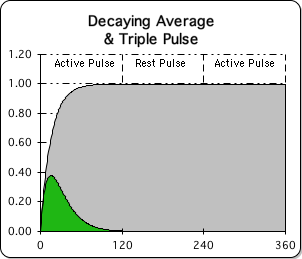
As seen in Graph B, if the data stream continues the numerical state past the prescribed interval, the info energy of the System (the data bits) is wasted on smaller and smaller increments of change. Hence less and less work is accomplished. We saw this mathematical phenomenon in our Sleep Necessity article. Notice how little activity there is in Graph B compared to Graph A. The Living Average (the indicator of how much work is accomplished) in Graph B rises to a maximum and then levels out, while Graph A's Living Average regularly moves from numerical location to location. Notice also that Graph B contains only 1 green pulse to Graph A's 3 – another indication of how much less is accomplished when the numbers don't alternate in the prescribed sequence.
Too Short
C. Duration of Numerical State Too Short
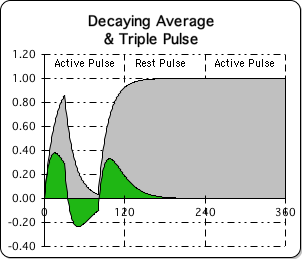
Conversely, if the data stream shifts from one number state to the other prematurely (before the mathematically prescribed interval), this diminishes the overall potential of the System to do work (Graph C). We saw this mathematical phenomenon in our Head Start Experiment. Notice how the Living Average (the grey area) never reaches its limit of one in the first pulse, nor does it reach its limit of zero in the 2nd pulse. The reduction in actual work performed is reflected in the green area, where each of the pulses in Graph C are severely diminished compared to the ideal potentials of their counterparts in Graph A. This analysis exhibits a prime tenet of the Living Algorithm's Triple Pulse System. The numerical state of the data stream must be maintained for a sufficient duration, not too long or too short, to maximize productivity.
Power & Efficiency
A significant aspect of the Triple Pulse System is that when it is most productive, it is also most efficient. The most efficient way of doing things gets the most accomplished in the least amount of time with the least amount of energy expenditure. Accordingly, the most efficient method also conserves energy.
Cars: Power Up; Efficiency Down
In general, this constructive relationship between productivity and efficiency does not remain true in material systems. Power, a component of Productivity, is most often inversely related to Efficiency. For instance, Power and Efficiency are inversely related when it comes to cars. Power up; Efficiency down. Usually the more horsepower a car has, the less fuel-efficient it becomes. Greater horsepower allows the car to gain speed more rapidly. But there is a cost. To fuel the surge the car consumes the gas energy more rapidly. Because these powerful cars are not fuel efficient, they are deemed gas-guzzlers. In general there is a trade-off in material systems between power and efficiency. The ability to do work rapidly expends more energy.
Maximum Info Energy of Triple Pulse System: 360 units
If there is an excess amount of energy to do work, wasting energy is not a problem. But when energy resources are limited, maximizing efficiency becomes very important. For instance, maximizing energy efficiency is very important to biological systems because their energy resources are finite. Similarly the Living Algorithm’s Triple Pulse System has finite resources. By definition, the Triple Pulse System only consists of 1s and 0s and the data stream contains 360 data bits. Hence, the System’s maximum info energy is 360 units. This limit can only be fully utilized when the data stream consists solely of ones. Conversely when the data stream contains any 0s whatsoever, the System utilizes less info energy than the maximum available (360 units of info energy).
‘On' Data Stream expends 360 info energy bits for only 1 unit of work
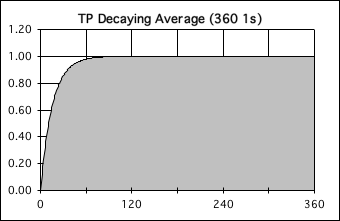
If all 360 energy bits (solely ones) are used, only the first 120 of them do any significant work. In the graph at right, notice how the curve rises and then levels out. Once the curve has reached its maximum, ‘work’ ceases. The initial 120 ones change the system’s numerical state from 0 to 1 (one mathematical unit). This is depicted as the rise in the curve of the Living Average. The remainder of the ones (240 of them) maintains the state of the System at one, but do not change it in any significant fashion. They’re just hangin' out, waitin’ for zeros. This is shown as the curve leveling out. The System could be ‘on’ all night (generating ones forever); but this would be a waste of info energy, as nothing more would be accomplished – similar to a car left idling – a lot of energy expended, but going nowhere. No change in the curve would occur without the arrival of a zero. If the Triple Pulse System remains ‘on’ continuously, it will utilize the entire 360 bits of info energy. Yet, this usage will only change the System by one mathematical unit - accomplishing only 1 unit of work.
On/Off Data Stream only expends 240 info energy bits, but does 3 units of work
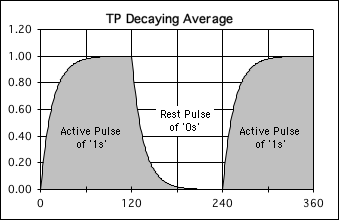
The most powerful and most efficient method of changing the System is to employ the Triple Pulse sequence: 120 on, 120 off, and 120 on (the On/Off Data Stream). Abiding by this sequence maximizes the changes to the System (the amount of work done). This is illustrated in the graph of the Living Average at the right. Alternating between the specified sequence of 1s and 0s utilizes 240 energy info bits (the 1’s), rather than the full 360, and changes the System by 3 mathematical units (from 0 to 1 to 0 to 1). This On-Off data stream accomplishes 3 times as much work as the data stream that remains on continuously. Further, the energy expenditure of the On-Off Data Stream is only 2/3 that of the ‘On’ Data Stream. Rather than consuming the entire 360 bits of info energy to change the System, the Triple Pulse employs less energy to accomplish more. Accordingly, the Triple Pulse sequence utilizes the System’s energy in the most efficient way. This makes the Triple Pulse System the ultimate in energy conservation. (Yet another reason you gotta love the Living Algorithm.)
Could Evolution choose the Triple Pulse System, as most efficient and most productive?
The info energy of the System – manifested as data bits – is used most efficiently (conserving the most energy) when the data stream consists of the ideal Triple Pulse sequence. Instead of wasting info energy on minuscule insignificant changes to the System, the data stream's numerical state must shift at regular intervals (illustrated above). These are all innate invariable mathematical features of the Living Algorithm’s Triple Pulse Info System. Let us suppose that biological systems employ the Living Algorithm to process information. Evolutionary mechanisms favor biological systems that maximize both productivity and efficiency, as these features facilitate survival. Accordingly, Evolution would choose systems that employ the Triple Pulse sequence, as it maximizes both the productivity and efficiency of the Living Algorithm System. We saw examples of how Evolution chose the Triple Pulse sequence in our articles on the Biology of Sleep and the Necessity of Sleep. Does this analysis suggest that biological systems employ the Living Algorithm to process information? If so, what are some of the other implications of this peculiar notion?
Links
In these many articles, we've discussed the congruencies between the dynamics of matter and dynamics of data streams. What about the points of departure between the two systems? For more, check out the next article in the series - Divergence: Living Algorithm vs. Material Dynamics.